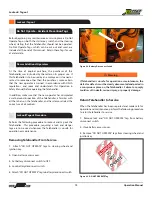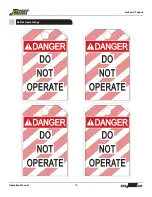
Operation Manual
71
Preventive Maintenance
Comply with 50-Hour Maintenance Requirements
Comply with 250-Hour Maintenance Requirements
Comply with 500-Hour Maintenance Requirements
Comply with 1000-Hour Maintenance Requirements
Change hydraulic fluid
Clean or replace hydraulic reservoir strainer
After Every 2,000 Hours of Operation
Drain and flush cooling system
After Every 4,000 Hours of Operation
Comply with 50-Hour Maintenance Requirements
Comply with 250-Hour Maintenance Requirements
Comply with 500-Hour Maintenance Requirements
Change wheel-end oil
Change differential oil
Inspect boom chains
After Every 1,000 Hours of Operation
Engine Diagnostic Fault Codes
The electronic engine control system displays and records cer-
tain detectable fault conditions. These failures are displayed
as fault codes, which make troubleshooting easier. The fault
codes are retained in the ECM.
There are two types of diagnostic codes:
•
Engine electronic control system fault codes inform the
operator that there is a problem with the control system
that requires troubleshooting.
•
Information and engine protection fault codes inform the
operator that the control system has detected an engine
condition outside the normal operating range.
All fault codes recorded will either be active (fault code is pres-
ently active on the engine) or inactive (fault code was active at
some time, but is not presently active).
The STOP ENGINE lamp is red and indicates the need to stop
the engine as soon as it can be safely done. The engine must
remain shut down until the engine can be repaired.
When illuminated, the yellow “WARNING” or “CHECK ENGINE”
lamp indicates that the engine is in need of repair at the first
available opportunity.
Another function of the WARNING or CHECK ENGINE lamp
(yellow lamp) is to flash for 30 seconds at key ON when one of
the following occurs:
•
Maintenance is required (if the Maintenance Monitor fea-
ture is enabled)
•
Water in fuel is detected.
If the warning light flashes for 30 seconds at Ignition Switch
ON and water is drained from the primary water-separating
fuel filter, the secondary fuel filter must be replaced.
Fault codes can be accessed using the electronic service tool
or by fault code flash out.
To check for active engine electronic fuel system and engine
protection system fault codes, turn the Ignition Switch OFF
and move the diagnostic switch to the ON position.
Turn the vehicle Ignition Switch to the ON position.
If no active fault codes are recorded, both lights will come on
and stay on.
If active fault codes are recorded, both lights will come on mo-
mentarily, then begin to flash the code numbers of the record-
ed fault codes.
The fault code flashes in the following sequence:
•
A WARNING (amber) light flashes.
•
Following a short one or two second pause, the number
of the recorded fault code flashes in the STOP (red) lamp.
•
There is a one or two second pause between each num-
ber.
•
After the number finishes flashing in red, an amber light
appears again.
The lights flash each fault code out three times before advanc-
ing to the next code. To skip to the next fault code, move the
Increment/Decrement switch, if equipped, momentarily to
the increment (+) position. You can go back to the previous
fault code by momentarily moving the Increment/Decrement
switch, if equipped, to the decrement (-) position. If only one
active fault code is recorded, the same fault code will contin-
uously be displayed when either (+) or (-) switch is depressed.
The diagnostic switch must remain in the OFF position (short-
ing plug removed) while the engine is being operated for all
fault codes to be logged.
Check cooling fan belt tensioner
Check electrical cables, leads, and connections for
damage and tightness
Check specific gravity of engine coolant
Replace transmission fluid and filters and perform the
required transmission calibration
Replace hydraulic reservoir air breather
Replace hydraulic return line filter
Replace hydraulic high-pressure filter






















